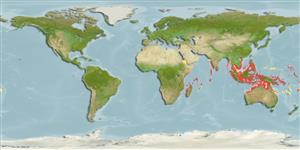>
Ovalentaria/misc (Various families in series Ovalentaria) >
Ambassidae (Asiatic glassfishes)
Etymology: Ambassis: Derived from Greek, anabasis = climbing up (Ref. 45335).
More on author: Bleeker.
Environment: milieu / climate zone / depth range / distribution range
Écologie
marin; eau douce; saumâtre démersal; amphidrome (Ref. 59012). Tropical; 19°N - 23°S
Asia: Indo-Australian Archipelago, including Indonesia, the Philippines, Borneo, Java, New Guinea, Vanuatu, New Caledonia, to northern Australia and the Andaman Sea. Reported from Palau (Ref. 6371) and the Ryukyu Islands (Ref. 559).
Length at first maturity / Taille / Poids / Âge
Maturity: Lm 7.0 range ? - ? cm
Max length : 12.0 cm TL mâle / non sexé; (Ref. 7050); common length : 5.0 cm SL mâle / non sexé; (Ref. 7242); poids max. publié: 12.00 g (Ref. 7242)
Épines dorsales (Total): 8; Rayons mous dorsaux (Total): 9-10; Épines anales 3; Rayons mous anaux: 9 - 10. Body very high, 50% of SL. Lateral line incomplete, but a few pored scales on a silvery midlateral band. Lower margin of inter operculum with few spines. The second spine of the first dorsal fin is strong and very long.
Found in brackish-water, mangrove, estuarine and freshwater-stream habitats, usually within 20 km of the sea (Ref. 2847). They occur at temperatures ranging from 28 to 32°C. Found in schools and migrate to freshwater. Mainly diurnal. A predominantly marine or estuarine spawner. Caught by hand and scoop nets (Ref. 7242).
A nonobligatory plant spawner.
Allen, G.R., 1991. Field guide to the freshwater fishes of New Guinea. Publication, no. 9. 268 p. Christensen Research Institute, Madang, Papua New Guinea. (Ref. 2847)
Statut dans la liste rouge de l'IUCN (Ref. 130435)
Menace pour l'homme
Harmless
Utilisations par l'homme
Warning: mysqli::__construct(): (HY000/1040): Too many connections in /var/www/html/includes/func_getlabel.php on line 46
Can't connect to MySQL database (fbapp). Errorcode: Too many connections
